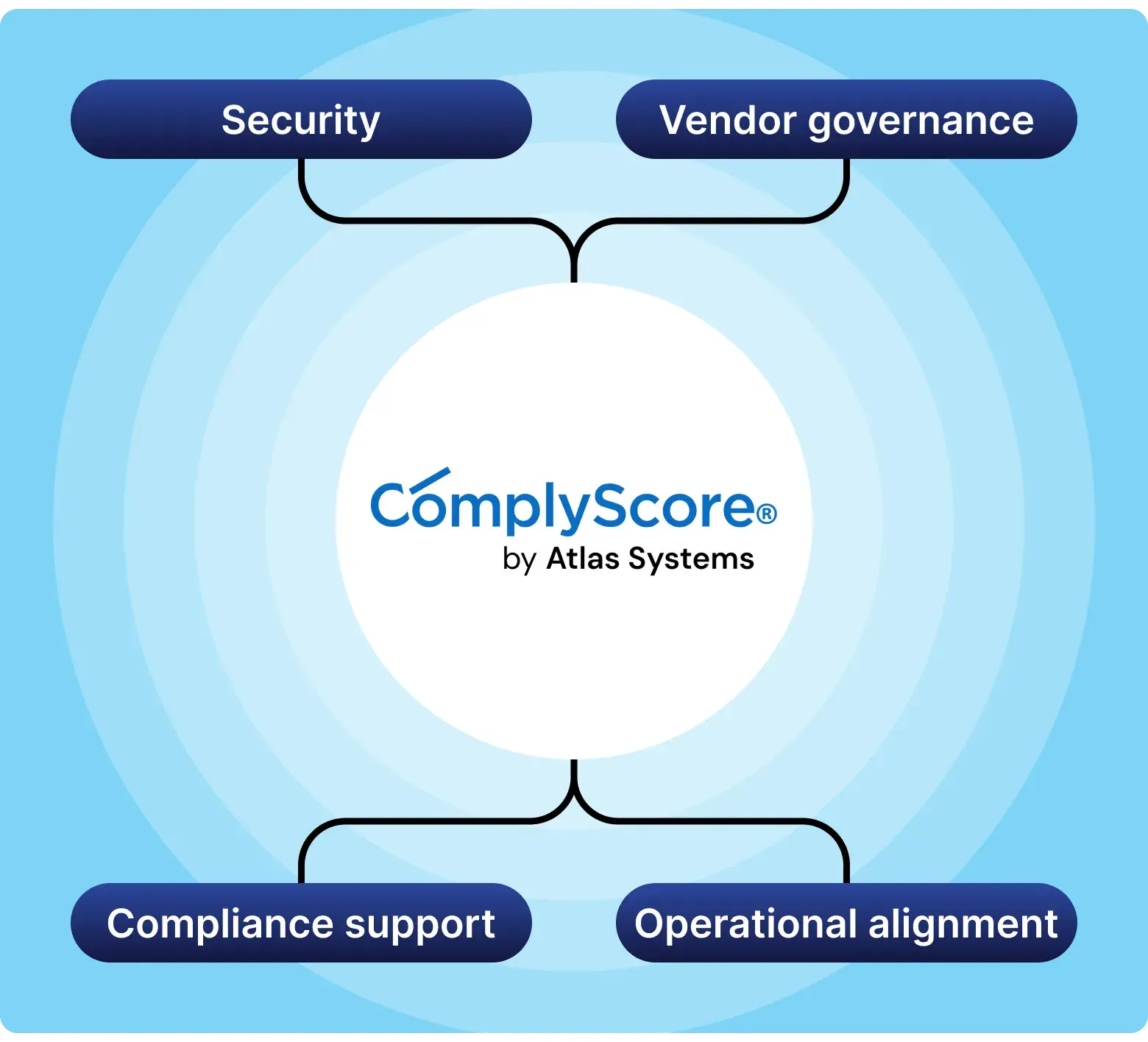Atlas Systems Named a Representative Vendor in 2025 Gartner® Market Guide for TPRM Technology Solutions → Read More
ComplyScore® by Atlas Systems
vs ProcessUnity
Explore how ComplyScore® and ProcessUnity compare across third-party risk management capabilities, regulatory alignment, automation depth, and usability — helping you choose the right platform for your organization’s risk and compliance strategy.

Trusted partner to market-leading brands

Key Differences Between ComplyScore® vs ProcessUnity
Category
ProcessUnity
ComplyScore®
Lifecycle Coverage
Third-party risk management with full-cycle support, but some users report fragmented workflows and clunky navigation.
End-to-end TPRM: onboarding, due diligence, contract tracking, remediation, and ongoing monitoring, unified under a single workflow.
Configurability
Customizable, but setup often requires coding skills, advanced rule logic, or developer involvement.
Built for rapid deployment with configurable templates that require no-code customization, easier onboarding, and updates.
Usability and Learning Curve
Noted challenges for frequent users: onboarding documentation and in-app guidance are often lacking.
Intuitive UI with guided onboarding, contextual help, and streamlined dashboards that scale from SMEs to large enterprises.
Risk Domain Coverage
Cybersecurity-focused with surface-level posture scanning across 70+ vectors. Limited internal control depth.
19+ domains including cyber, legal, ESG, financial, and privacy. Deep control mapping tailored for regulated industries.
Workflow Automation
Offers automation for assessments and alerts, but lacks flexible escalation handling or custom document logic.
Automation is baked into vendor onboarding, tiering, issue escalation, and report generation. Designed for operational agility.
AI Capabilities
AI for scan-based risk scoring and evidence evaluation.
AI powers multilingual assessments, sentiment scoring, auto-risk tiering, and contextual reporting tuned for compliance frameworks.
Assessment Customization
Limited ability to merge assessments and workflows; lacks support for flexible formats and combined views.
The assessment engine supports multilingual, dynamic formats with single-view reporting and status consolidation.
Regulatory Alignment
Aligned with ISO 27001 and NIST. Limited native support for region-specific laws like India DPDP or HIPAA.
Fully aligned with GDPR, HIPAA, ISO, NIST, SOC 2, HITRUST, and India DPDP optimized for healthcare, BFSI, and global compliance needs.
Performance
Reports of noticeable lag, load delays, and slow navigation on larger portfolios.
Optimized for performance with responsive dashboards and cloud-native architecture that scales under load.
Support Model
Responsive team, but limited implementation guidance or strategic support for complex orgs.
Backed by 100+ global SMEs offering proactive, guided deployment and risk-lifecycle advisory.
TPRM as a Managed Service
Not offered.
Offers Third-Party Risk Assessment-as-a-Service across 65+ countries with custom reporting and remediation planning.
Credential and License Monitoring
Not available; vendors must track externally.
Tracks regulatory credentials, licenses, and certifications with expiry alerts and gap visibility.
Contract and Renewal Tracking
Requires external tools or custom integrations.
Natively tracks contract terms, SLAs, renewal dates, and alerts, enabling tighter compliance control.
Threat and Vulnerability Response
Strong capabilities including CVE-driven prioritization and Global Risk Exchange integration.
Supports threat response with real-time alerts, but adds compliance-aligned escalation flows and deeper third-party tiering logic.
Reporting and Dashboards
Powerful reporting, but limited user filtering and sorting. Alphabetical date sort noted as a major issue.
Advanced dashboards with role-based views, filtering, date intelligence, and audit-ready exports.
Integration and API
Open APIs with Zapier, Jira, and ServiceNow support. Broad app integration but limited GRC depth.
Seamless ERP and GRC integration with detailed risk data mapping, custom APIs, and domain-specific ingestion pipelines.
Why is ComplyScore® the Best Alternative to ProcessUnity?
See how ComplyScore® and ProcessUnity compare on core third-party risk and compliance management features.
Features |
ProcessUnity |
ComplyScore® |
|---|---|---|
Full Lifecycle Risk Management |
|
|
AI-Powered Automation |
|
|
Regulatory Framework Support |
|
|
Customizable Workflows |
|
|
Dynamic Risk Tiering |
|
|
Enterprise Compliance Readiness |
|
|
Assessment-Driven Workflows |
|
|
Credential and License Monitoring |
|
|
Contract and Renewal Tracking |
|
|
TPRM as a Managed Service |
|
|
Operational Risk Management |
|
|
Real-Time Dashboards and Reporting |
|
|
Performance Optimization |
|
|
Compliance and Regulatory Monitoring |
|
|
Reasons to Consider ComplyScore® by Atlas Systems Over ProcessUnity
ProcessUnity is a recognized name in third-party risk management, offering strong automation and threat response capabilities. However, for organizations seeking enterprise-grade vendor governance, simplified deployment, and deep compliance alignment, ComplyScore® stands apart as the purpose-built choice.

Enterprise-Grade Advantages with ComplyScore®
Unified Vendor Workflows
ComplyScore® offers a single-view workflow that spans onboarding, risk scoring, document tracking, and continuous monitoring, removing confusion and minimizing manual clicks.
Configuration Without Code
While ProcessUnity is praised for being flexible, it often demands advanced configuration skills and formula logic, adding time and training requirements. ComplyScore® enables rapid deployment with pre-built templates and no-code customization, making it easier for compliance teams to manage programs independently.
Built-In Credential and Contract Oversight
ProcessUnity lacks native support for tracking certifications, license expirations, or contract terms. ComplyScore® fills this gap with integrated contract and renewal tracking and credential/license monitoring, ensuring audit-readiness and SLA compliance without relying on third-party tools.
Global Compliance from Day One
Unlike ProcessUnity, which has strong alignment with ISO and NIST but limited native support for regional mandates (like India’s DPDP or HIPAA), ComplyScore® is pre-aligned with global frameworks, including HIPAA, GDPR, HITRUST, SOC 2, ISO 27001, and DPDP. This ensures regulatory confidence across industries and geographies.
Risk Assessment-as-a-Service
With 100+ global SMEs, ComplyScore® delivers managed risk assessments, customized remediation, and contextual reporting. Now enhanced with Tenable-powered attack surface, vulnerability, and cloud security scans, you get real-time insights across both compliance and cybersecurity domains, at no added complexity.
Lightweight, Responsive Experience
Users report sluggish load times and clunky filtering within the ProcessUnity UI. ComplyScore® delivers a streamlined user experience, built for speed and scale, with real-time dashboards, intuitive sorting, and minimal click fatigue.
How Carelon Behavioral Health Transformed TPRM with ComplyScore®
Discover how Carelon Behavioral Health replaced manual risk processes with real-time, AI-powered vendor governance, achieving compliance confidence, cost efficiency, and operational agility with ComplyScore®.
“Atlas far exceeds expectations in terms of cost-efficiency and ease of use.”

Izhar Mujaddidi,
Senior Director – Cybersecurity
.png?width=869&height=597&name=image%20(5).png)

.png?width=300&height=175&name=Rectangle%2034624433%20(2).png)




